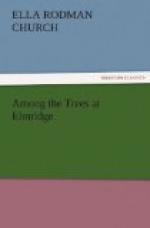“It’s nice to breathe here,” said Clara.
“It is delicious,” replied her governess, enthusiastically, her eyes kindling as she repeated the lines:
“’His praise,
ye winds, that from four quarter blow,
Breathe soft and loud;
and wave your tops, ye pines,
With every plant, in
sign of worship. Wave!’”
“What a queer brown color—almost like red—the ground is!” said Malcolm. “And look, Miss Harson! it’s made of lots of little sharp sticks.”
“The sharp sticks are pine-needles,” was the reply—“the dead pine-leaves of last year; and when the new growth of leaves have been put forth, they cover the ground with a smooth brown matting as comfortable as a gravel-walk, and yet a carpet of Nature’s making. ’The foliage of the pine is so hard and durable that in summer we always find the last year’s crop lying upon the ground in a state of perfect soundness, and under it that of the preceding year only partially decayed.’”
“It’s kind of slippery in some places,” continued Malcolm, taking a slide as he spoke. “And see those queer-looking roots sprouting out of the ground!”
“I see the roots,” said Miss Harson, “but no sprouts. That is the white pine, the roots of which are often seen above the ground, spreading to some distance from the trunk. Generally the roots of pine trees are small, compared with the size of the trunks, and spread horizontally instead of descending far into the ground. For this reason pines are often uprooted by high winds, which break off the deciduous trees near the ground. But I wish you particularly to notice the trunks of these trees and tell me if you can see any difference in them.”
Those particular trees had probably never been stared at so hard before, and the three children exclaimed almost together:
“Some are rough, and some are smooth, and the rough ones have little bunches of leaves on ’em.”
“These are the pitch-pines,” replied their governess. “They are the roughest of all our forest-trees, and they have a rounder head than any of the other American evergreens. The branches, you see, turn in various directions and are curved downward at the ends. This tree has also the peculiar habit of sending out little branchlets full of leaves along the stem from the root upward, and this has a very pretty effect, like that of some elm trees. It is the pitch-pine that produces the fragrance we are all enjoying so much. What do you notice about the smoother trees?”
“They are very tall and big,” replied Clara—“ever so much handsomer than the rough ones.”
[Illustration: THE WHITE PINE.]
“The white pine,” said Miss Harson, “is one of the loftiest and most valuable of North American trees. Its top can be seen at a great distance, looking like a spire as it towers above the heads of the trees around it. You see that it has widespread branches and silken-looking, tufted foliage. The leaves are in fives and not so stiff as those of the other pines, and you will notice that the branches are in whorls, like a series of stages one above another. The foliage has a tasseled effect with those long silky tufts at the ends of the branches, and the whole outline of the tree is very pleasing.”




